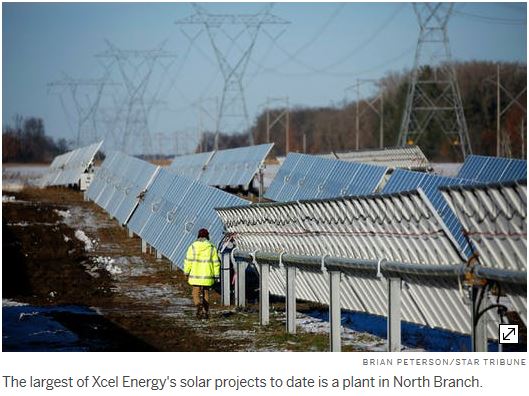Xcel Energy would accelerate nearly $3 billion in spending, particularly on large renewable-energy projects, in response to calls from state utility regulators to jolt Minnesota’s economy from its coronavirus-induced lethargy. Xcel’s proposal Wednesday calls for a new solar plant in Becker that would be at least four times larger than Minnesota’s current largest solar array. Also, Xcel would speed up plans to “repower” four older wind farms with new turbines and other new equipment.
“We tried to put together a sizable proposal,” said Christopher Clark, Xcel’s president for Minnesota and the Dakotas. “The wind and solar are really the biggest pieces.”
The Minnesota Public Utilities Commission (PUC) in early May requested that the state’s electric and gas utilities explain how they could “assist in Minnesota’s economic recovery from the COVID-19 pandemic.”
Also in response to the PUC, Duluth-based Minnesota Power on Wednesday announced plans to triple its solar capacity with three new arrays around northern Minnesota, a $40 million investment.
The new Minnesota Power solar plants, which together could produce up to 20 megawatts of electricity, are planned at the Laskin Energy Center in Hoyt Lakes, the Sylvan Hydro Station near Brainerd and at an unidentified site in Duluth. “Moving up the timetable of planned solar projects will boost the tax base of local economies, add solar panels from regional manufacturers when possible, and support local construction jobs,” Minnesota Power CEO Bethany Owen said in a statement.
Most of the construction on the three projects will take place in 2021.
Minneapolis-based Xcel, the state’s largest electric utility, said it hopes to create 3,000 jobs with its initiatives. Xcel’s wind and solar proposals would still likely need to traverse the same state regulatory process for all major utility projects. And it could be many months if not years before work gets rolling on Xcel’s largest proposals. Still, Clark said that in order to kick-start some employment this year, Xcel plans to accelerate millions of dollars in spending on capital projects in myriad areas, from electric vehicles to electricity distribution to dismantling no-longer used power plants.
The biggest element of Xcel’s proposal would be repowering four wind farms, which would cost $1 billion to $1.4 billion, Clark said. Xcel had planned to bring two of those repowering projects before the PUC later this year. The other two were set for later in the 2020s. The retooled wind farms would be able to take advantage of federal tax credits. The repowering projects would be slated to start as current construction on several other Xcel wind farms is completed. “The result would be a solid pipeline of work,” Clark said.
Xcel would also be able to use federal tax credits for a 450-megawatt solar plant, which would cost up to $650 million and be located next to the company’s big coal-fired plant in Becker. Xcel plans to close two of its Becker coal generators between the end of 2023 and the end of 2026, and a third in 2030.
Currently, the largest solar farm in Minnesota is Xcel’s 100-megawatt plant near North Branch.
Xcel had been planning to bring online about 3,000 megawatts of new solar power from 2026 through 2030 as Xcel’s coal plants are shut. The company’s new proposal would likely have the Becker solar plant operating by 2023 if not earlier. Clark said Xcel said that any rate increases needed to fund the projects would be “smoothed” and “flattened” so that they would be less than the rate of inflation. Xcel is expected to file for a rate case later this year.
Minnesota Power said that recent rate-case settlement dictates that the company can’t begin asking for another rate increase — should one be needed to cover the solar investment — until March 2021.
Residential electric rates have been rising in Minnesota in recent years; the state once sported rates comfortably below the national average, but no more, a 2019 Star Tribune analysis found.
“If there are investments that utilities could make that can boost the economy without burdening their customers, that would be good,” said Annie Levenson-Falk, head of the rate payer watchdog group Citizens Utility Board of Minnesota. However, she said, “We have to take a look at the details of what is being proposed.”
